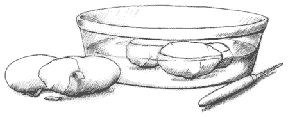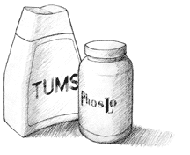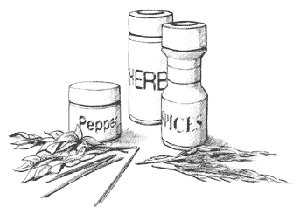
DIET
|
When you
start hemodialysis, you must make many changes in your life.
Watching the foods you eat will make you healthier. This article
will help you choose the right foods.
Food gives you energy and helps your body repair itself. Food is
broken down in your stomach and intestines. Your blood picks up
nutrients from the digested food and carries them to all your
body cells. These cells take nutrients from your blood and put
waste products back into the bloodstream. When your kidneys were
healthy, they worked around the clock to remove wastes from your
blood. The wastes left your body when you urinated. Other wastes
are removed in bowel movements.
Now your kidneys have stopped working. Hemodialysis removes
wastes from your blood. But between sessions, wastes can build
up in your blood and make you sick. You can reduce the amount of
wastes by watching what you eat and drink. A good meal plan can
improve your dialysis and your health.
Your clinic has a dietitian to help you plan meals.
A dietitian specializes in food and nutrition. A dietitian with
special training in care for kidney health is called a renal
dietitian. |
|
|
|
What
do I need to know about Fluids
You already know you need to watch how much you drink. Any food
that is liquid at room temperature also contains water. These
foods include soup, Jell-OŽ, and ice cream. Many fruits and
vegetables contain lots of water, too. They include melons,
grapes, apples, oranges, tomatoes, lettuce, and celery. All of
these foods add to your fluid intake.
Fluid can build up between dialysis sessions, causing swelling
and weight gain. The extra fluid affects your blood pressure and
can make your heart work harder. You could get serious heart
trouble from overloading your system with fluid.
Control your thirst!
You can keep your fluids down by drinking from smaller cups or
glasses. Freeze juice in an ice cube tray and eat it like a
popsicle. (Do not forget to count the popsicle in your fluid
allowance!) The dietitian will be able to give you other tips
for managing your thirst.
|
|

Your dry weight is your weight after a
dialysis session when all of the extra fluid in your body has
been removed. If you let too much fluid build up between
sessions, it is harder to get down to your proper dry weight.
Your dry weight may change over a period of 3 to 6 weeks. Talk
to your doctor regularly about what your dry weight should be.
Even though you are on hemodialysis, your kidneys may still be
able to remove some fluid. Or your kidneys may not remove any
fluid at all. That is why every patient has a different daily
allowance for fluid. Talk to your dietitian about how much fluid
you can have each day. |
Back
to menu |
|
What
do I need to know about Potassium
Potassium is a mineral
found in many foods, especially milk, fruits, and vegetables. It
affects how steadily your heart beats. Healthy kidneys keep the
right amount of potassium in the blood to keep the heart beating
at a steady pace. Potassium levels can rise between dialysis
sessions and affect your heartbeat. Eating too much potassium
can be very dangerous to your heart. It may even cause death.
To control potassium levels in your blood, avoid foods like
avocados, bananas, kiwis, and dried fruit, which are very high
in potassium. Also, eat smaller portions of other high-potassium
foods. For example, eat half a pear instead of a whole pear. Eat
only very small portions of oranges and melons. |
|

Dialyzing potatoes and other vegetables
You can remove some of the potassium from potatoes and other
vegetables by peeling them, then soaking them in a large amount
of water for several hours. Drain and rinse before cooking. Your
dietitian will be giving you more specific information about the
potassium content of foods.
Make a food plan that reduces the potassium in your diet. Start
by noting the high-potassium foods (below) that you now eat. A
dietitian can help you add other foods that are not on the list. |
Apricots
Clams
Figs
Kiwi fruit
Lima beans
Sardines
Prune Juice
|
Peanuts
Potatoes
Prunes
Avocados
Dates
Yoghurt
Spinach
|
Brussel
sprouts
Beets
Bananas
Cantaloupe
Milk
Tomatoes
Winter Squash
|
Pears
(fresh)
Nectarines
Raisins
Melons
Oranges
Orange juice
|
|
Back
to menu
|
|
What
do I need to know about Phosphorous
Phosphorus
is a mineral found in many foods. If you have too much
phosphorus in your blood, it pulls calcium from your bones.
Losing calcium will make your bones weak and likely to break.
Also, too much phosphorus may make your skin itch. Foods like
milk and cheese, dried beans, peas, colas, nuts, and peanut
butter are high in phosphorus. Usually, people on dialysis are
limited to 1/2 cup of milk per day. The renal dietitian will
give you more specific information regarding phosphorus.
|
|
You probably will need
to take a phosphate binder like PhosLo, Tums, or calcium
carbonate to control the phosphorus in your blood between
dialysis sessions. These medications act like sponges to soak
up, or bind, phosphorus while it is in the stomach. Because it
is bound, the phosphorus does not get into the blood. Instead,
it is passed out of the body in the stool.
 |
Back
to menu
|
|
What
do I need to know about Protein
Before
you were on dialysis, your doctor may have told you to follow a
low-protein diet. This is changed now. Most people on dialysis
are encouraged to eat as much high-quality protein as they can.
The better nourished you are, the healthier you will be. You
will also have greater resistance to infection and recover from
surgery more quickly
|
|
Protein helps you keep
muscle and repair tissue. In your body, protein breaks down into
a waste product called urea. If urea builds up in your blood,
you can become very sick. Some sources of protein produce less
waste than others. These are called high-quality proteins.
High-quality proteins come from meat, fish, poultry, and eggs
(especially egg whites). Getting most of your protein from these
sources can reduce the amount of urea in your blood. |
Back
to menu
|
|
What
do I need to know about Sodium
Sodium is
found in salt and other foods. Most canned foods and frozen
dinners contain large amounts of sodium. Too much sodium makes
you thirsty. Then, if you drink more fluid, your heart has to
work harder to pump the fluid through your body. Over time, this
can cause high blood pressure and congestive heart failure.
Do not use salt substitutes because these contain potassium.
Talk to a dietitian about other spices for your food. The
dietitian can help you find spice blends without sodium or
potassium.
|
|

Try to eat fresh foods that are
naturally low in sodium. Look for products labeled low
sodium. |
Back
to menu
|
|
What
do I need to know about Calories
Calories
provide energy for your body. If your doctor recomends it, you
may need to cut down on the calories you eat. A dietitian can
help you plan ways to cut calories in the best possible way.
But some
people on dialysis need to gain weight. You may need to find
ways to add calories to your diet. Vegetable oils--like olive
oil, canola oil, and safflower oil--are good sources of
calories. Use them generously on breads, rice, and noodles.
|
|
Butter and margarines are rich in
calories. But these fatty foods can also clog your arteries. Use
these less often. Soft margarine that comes in tubs is better
than stick margarine. Vegetable oils are the healthiest way to
add fat to your diet if needed.
Hard candy, sugar,
honey, jam, and jelly provide calories and energy without
clogging arteries or adding other things that your body does not
need. If you have diabetes, be very careful about eating
sweets. A dietitian's guidance is very important for people with
diabetes.
|
Back
to menu
|
|
Should
I take Vitamins & Minerals
Vitamins
and minerals may be missing from your diet because you have to
avoid so many foods. Your doctor may prescribe a vitamin and
mineral supplement like Nephrocaps.
|
|
Warning:
Do not take vitamins that you can buy off the store shelf. These
may contain vitamins or minerals that are harmful to you. Only
take vitimains prescribed by your doctor. |
Back
to menu
|
|
Resources:
Books
Owes
and Church's Food Values of Portions Commonly Used.
Seventeenth Edition.
Jean A. T. Pennington. J. P. Lippincott Co. 1997.
ISBN: 0-397-55435-4.
The
Complete Book of Food Counts. Fourth Edition.
Corinne T. Netzer. Dell Publishing Co. 1997.
ISBN: 0-440-22110-2.
Cookbooks
These
cookbooks provide recipes for people on dialysis:
The
Renal Gourmet. Mardy Peters
Emenar Inc.
320 Charmille Lane
Wood Dale, IL 60191
ISBN: 0-9641730-0-X
Phone: 1-800-445-5653
Southwest Cookbook for People on Dialysis
Developed by the El Paso Chapter Council
on Renal Nutrition and the National Kidney Foundation of Texas,
Inc.
Published by a grant from Amgen Inc.
Cookbooks are available from the
National Kidney Foundation of Texas
13500 Midway Road, Suite 101
Dallas, TX 75244
Phone: (972) 934-8057
|
|
Charts and posters
Kidney HELPER Potassium
Guide,
Kidney HELPER Phosphorus Guide. (Chart or poster)
Available from Consumer MedHelp
94 New Salem Street, Suite 104
Wakefield, MA 01880-1906
Phone: 1-800-556-7117 or (617) 246-7700
Fax: (617) 246-3086
Picture Renal Diet. (Poster)
Available from University Hospital, Food
and Nutrition Services
619 South 19th Street, Birmingham, AL 35233
Phone: (205) 934-8055
Brochures
Nutrition and Hemodialysis,
How To Increase Calories in Your Renal Diet.
National Kidney Foundation.
30 East 33rd Street, New York, NY 10016.
Phone: 1-800-622-9010 or (212) 889-2210.
www.kidney.org
Creative Cooking for Renal Diets,
Creative Cooking for Renal Diabetic Diets
Cleveland Clinic Foundation
Senay Publishing
P.O. Box 397
Chesterland, OH 44026
ISBN: 0-941511-00-6
Phone: (440) 256-4435
|
Back
to menu
|

